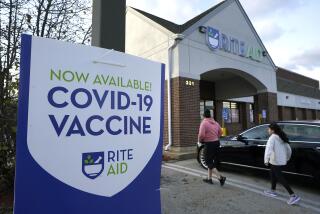Project Offers Eye Care for Those Over 65 : Referrals Help Seniors Find Low-Cost Aid
- Share via
Less than six months into its implementation in California, an eye-care project for senior citizens is producing at least one startling statistic: 52% of those screened had cataracts, 95% of which are curable by surgery.
The National Eye Care Project, already operating in several states, is designed to bring eye care to people over 65 at no cost to the patient. Half of the nation’s blind are over 65, although that age group is only 11% of the population. Begun in January in California, as well as some other states, the $3-million venture will become nationwide July 22 when the final link, New York City, joins the system.
Hot Line for Referrals
Sponsored by the Foundation of the American Academy of Ophthalmology and 50 similar state societies, the National Eye Care Project provides a telephone hot line through which seniors can get referrals to ophthalmologists in their areas.
Criteria are that the caller must be 65 or older and a U.S. citizen and must not have seen an ophthalmologist in the past three years. Those calling the hot line, 1-800-222-EYES, receive, in addition to referral if warranted, literature on eye care.
Nationwide, nearly 7,000 ophthalmologists have volunteered to see referred patients at no cost to the patient, according to Sanford Feldman, a San Diego eye surgeon who is working with the project as assistant vice president of the California Academy of Ophthalmology.
The doctors have agreed to accept whatever insurance companies or Medicare will pay as payment in full; if a patient has no insurance or Medicare, they will see the patient for free. They also will continue medical care as long as necessary to treat conditions diagnosed initially. The program, however, does not cover medications, eyeglasses or hospital services.
One of the principal goals of the program, Feldman said, is to reach seniors who have been out of the medical eye-care system for many years.
In California, a surprising 32% of callers had never seen a medical eye doctor, said Merrill Knopf, a Long Beach ophthalmologist working with the program.
“We have done a very poor job of educating the society to take care of eye diseases,” Knopf said, adding that those over 55 should see an ophthalmologist every two years.
Of nearly 17,000 Californians who called the Eye Care Project’s toll-free number, 10,896 visited a medical eye doctor. Of those, 5,698--52.3%--were found to have cataracts, 1,277 (11.7%) macular degeneration and 483 (4.4%) glaucoma.
Surprisingly, 58 patients had a retinal detachment they didn’t know about, Knopf said.
“How could they not know? Many will not admit to themselves that anything might be wrong,” he said. “They are frightened (of an eye problem), afraid to deal with it.”
The American Academy of Ophthalmology estimates that half of all blindness is preventable if detected and treated early.
The National Eye Care Project is budgeted at $3 million, roughly one-third for long-distance telephone charges, one-third for production of materials, postage and staff services, and the rest for a sophisticated computer system that matches callers with doctors geographically, keeps records and tells those answering calls what questions to ask.
Funding is entirely from the private sector, with about half from the ophthalmologists and the rest from community organizations and corporations associated with the eye-care profession.






